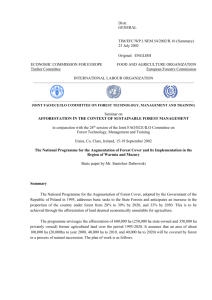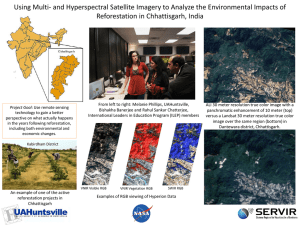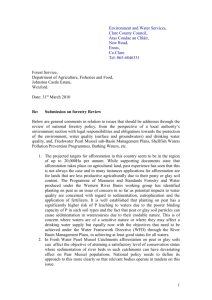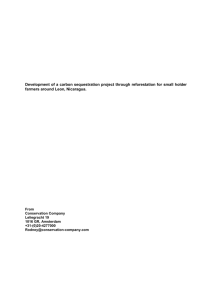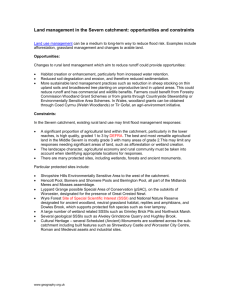General Guidelines
advertisement
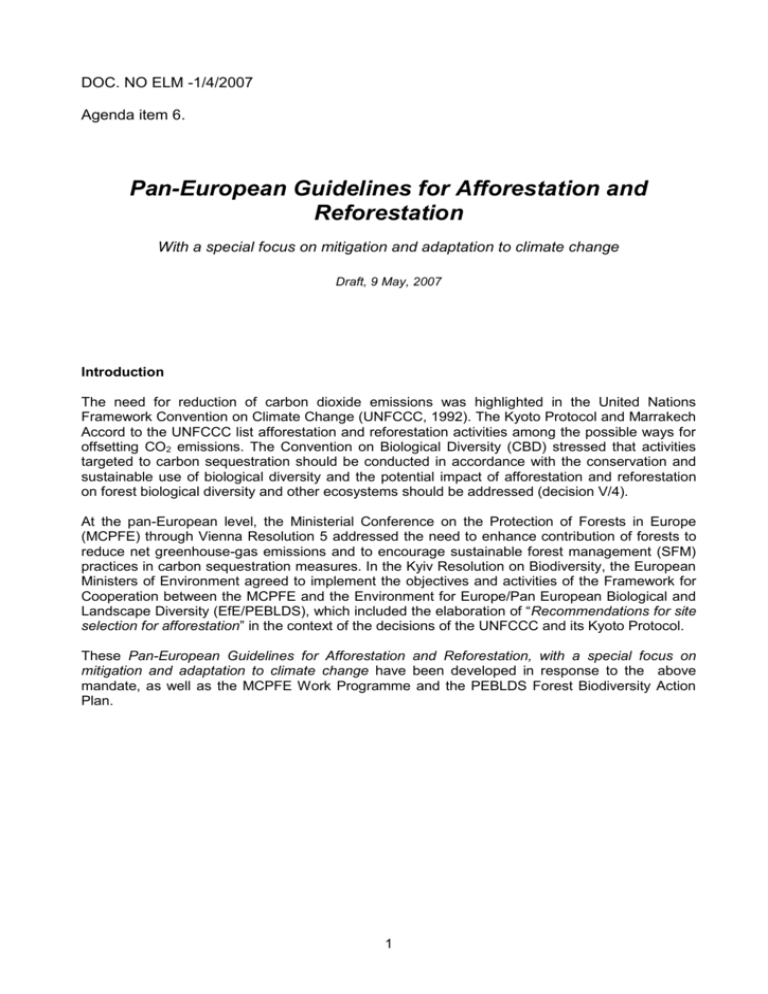
DOC. NO ELM -1/4/2007 Agenda item 6. Pan-European Guidelines for Afforestation and Reforestation With a special focus on mitigation and adaptation to climate change Draft, 9 May, 2007 Introduction The need for reduction of carbon dioxide emissions was highlighted in the United Nations Framework Convention on Climate Change (UNFCCC, 1992). The Kyoto Protocol and Marrakech Accord to the UNFCCC list afforestation and reforestation activities among the possible ways for offsetting CO2 emissions. The Convention on Biological Diversity (CBD) stressed that activities targeted to carbon sequestration should be conducted in accordance with the conservation and sustainable use of biological diversity and the potential impact of afforestation and reforestation on forest biological diversity and other ecosystems should be addressed (decision V/4). At the pan-European level, the Ministerial Conference on the Protection of Forests in Europe (MCPFE) through Vienna Resolution 5 addressed the need to enhance contribution of forests to reduce net greenhouse-gas emissions and to encourage sustainable forest management (SFM) practices in carbon sequestration measures. In the Kyiv Resolution on Biodiversity, the European Ministers of Environment agreed to implement the objectives and activities of the Framework for Cooperation between the MCPFE and the Environment for Europe/Pan European Biological and Landscape Diversity (EfE/PEBLDS), which included the elaboration of “Recommendations for site selection for afforestation” in the context of the decisions of the UNFCCC and its Kyoto Protocol. These Pan-European Guidelines for Afforestation and Reforestation, with a special focus on mitigation and adaptation to climate change have been developed in response to the above mandate, as well as the MCPFE Work Programme and the PEBLDS Forest Biodiversity Action Plan. 1 Purpose and Scope These guidelines form a common framework of recommendations for European afforestation and reforestation programmes .The guidelines are voluntary and have been developed for national authorities, other relevant bodies and stakeholders involved in respective programmes and projects. The guidelines support synergies in implementing the United Nations Forum on Forests (UNFF), UNFCCC, CBD, United Nations Convention on Combating Desertification (UNCCD), and other relevant forest-related international commitments. The pan-European policy recommendations set out below provide guidance for implementing economically viable, environmentally sound, and socially equitable and culturally acceptable afforestation and reforestation activities and projects. They are complementary to the existing MCPFE commitments and tools to implement SFM, in particular the General Guidelines for the SFM in Europe (Resolution H1) and the Pan European Operational Level Guidelines (PEOLG), (Annex 2 of Resolution L2). Furthermore, they address specific pan-European issues in balancing afforestation needs, needs of other land-users and the conservation of sites of high ecological, landscape and cultural value. They contribute to the achievement of the CBD provisions, such as those related to the ecosystem approach, the Pan-European 2010 Biodiversity Targets as well as to other relevant internationally agreed goals. These guidelines are designed for application in the Pan-European region for all afforestation and reforestation programmes aiming towards carbon sequestration and reduction of net CO 2 emissions inter alia, through biomass production. This set of pan-European guidelines is also a contribution to the deliberations in the UNFCCC in reviewing modalities and procedures for afforestation and reforestation activities. In this context, the guidelines may serve, if applicable, as guidance for developing and implementing the Clean Development Mechanism (CDM) and other international projects. General Guidelines 1. Use the Pan-European Criteria and Indicators for Sustainable Forest Management as an overall framework for afforestation and reforestation programmes as well as the PanEuropean Operational Level Guidelines for SFM as a tool to promote the sustainable management of afforestation and reforestation at the management unit level. 2. Ensure that, at the landscape level1, afforestation and reforestation projects maintain or improve the provision of ecosystem goods and services and meet biodiversity and sustainable livelihood objectives. 3. Ensure that all afforestation and reforestation measures for increasing carbon sequestration and biomass/energy production are in line with the pan European guidelines for SFM, as aligned with the Ecosystem Approach2, taking into account economic, environmental, social and cultural aspects in a balanced way. 4. Ensure that all wood production including short rotation and fast growing plantations is guided by the principles of sustainability. 2 5. Promote the consideration of these afforestation and reforestation guidelines in national policies, legislation and programmes related to forestry (e.g. National Forest Programmes), biodiversity (e.g. National Biodiversity Strategies and Action Plans), land use planning and management, integrated water management and agriculture. 6. Promote synergies in implementing relevant national and regional programmes related to international commitments under UNFF, UNCCD, UNFCCC, and CBD when carrying out afforestation and reforestation activities. 7. Promote the development of afforestation and reforestation projects that benefit both biodiversity conservation and climate change mitigation. 8. Ensure clear administrative responsibilities within countries regarding afforestation and reforestation programmes and provide for effective information sharing and cross-sectoral cooperation between relevant authorities and stakeholders involved. 9. Assess environmental, cultural and socio-economic impacts of planned afforestation and reforestation programmes, in accordance with internationally agreed environmental impact assessment procedures, as appropriate, in consultation with local communities and relevant stakeholders. 10. Ensure that afforestation and reforestation programmes take into account relevant traditional knowledge. 11. Include afforestation and reforestation areas in existing national monitoring schemes to evaluate economic, environmental, social and cultural impacts of implemented afforestation and reforestation activities and their carbon balances. 12. Encourage research on afforestation and reforestation in the context of climate change, such as research on species and provenances adaptation, as well as inter-disciplinary research on the economic, environmental, social and cultural aspects of afforestation and reforestation. 13. Raise public awareness on environmental issues related to afforestation and reforestation and the potential economic and social benefits of afforestation and reforestation. Ecological Guidelines 14. Apply the precautionary principle when developing policies and planning for afforestation and reforestation programmes, including site selection, to avoid negative impacts on areas of high ecological value, particularly natural non-forest ecosystems and areas of high soil carbon stock. 15. Promote afforestation and reforestation with native tree species or provenances of species that are well adapted to site conditions now and in the future. 16. Use only species, provenances, varieties or ecotypes outside their natural range where their introduction would not endanger important and/or valuable indigenous ecosystems, flora and fauna. Take into account the need to adapt to climate change when choosing species, provenances and varieties or ecotypes. Take measures to avoid the use of invasive alien species using the CBD guiding principles3. 17. Discourage the use of genetically modified trees and apply the precautionary principle in this regard4. 3 18. Promote species composition and structural diversity in afforestation and reforestation programmes, reflecting the natural diversity at the landscape level. 19. Promote afforestation and reforestation activities that contribute to the improvement and restoration of ecological connectivity5. 20. Discourage the use of chemicals such as fertilizers, herbicides and pesticides. 21. Aim to maintain and protect all ground and surface water resources in terms of quantity and quality in all afforestation and reforestation activities. Socio-economic and Cultural Guidelines 22. Promote afforestation and reforestation projects that also enhance economic and social well-being of local communities, including workers and contractors. 23. Ensure appropriate mechanisms, including legislation, so that afforestation and reforestation for carbon sequestration and biomass production follow SFM and respect priorities for income generation, rural livelihoods and poverty alleviation. 24. Secure land tenure rights and clarify access rights as well as responsibilities for management of resources when developing afforestation and reforestation programmes. 25. Consider the development and enhancement of incentives for afforestation and reforestation programmes designed in accordance with these guidelines. 26. Promote cross-sectoral coherence between incentives for afforestation and reforestation programmes and other relevant policies inter alia rural development, energy, agriculture, land use planning, water, environmental, and climate change policies. 27. Encourage public and private financial institutions and funds to use criteria6 which provide for economically viable, environmentally sound, socially equitable and culturally acceptable afforestation and reforestation projects in the evaluation of those projects for financing. 28. Ensure that decisions regarding afforestation and reforestation policies, programmes and large- scale projects are developed in consultation with land owners, local communities and other relevant stakeholders. 29. Take into account all landscape values, including maintenance of high value cultural landscapes7, cultural heritage sites8 and sacred cultural sites, in the elaboration of policies and planning procedures for afforestation and reforestation activities. 1 Landscape means an area as perceived by people whose character is the result of the actions and interactions of natural and/or human factors (European Landscape Convention, 2000). 2 It is understood by the MCPFE and the PEBLDS processes that SFM, as defined and further developed by the MCPFE, is consistent with the application of the Ecosystem Approach to forest ecosystems in the pan-European region (Source: MCPFE/PEBLDS 2006, Joint position of the MCPFE and the EfE/PEBLDS on the Pan-European understanding of the linkage between the ecosystem approach and sustainable forest management). 3 Guiding Principles for the Prevention, Introduction, and Mitigation of Impacts of Alien Species That Threaten Ecosystems, Habitats or Species (CBD decision VI/23) . 4 In accordance with CBD decision VIII/19. 5 IUCN defines connectivity as a term describing the existence of functional continuity although there is no structural continuity. 6 For example, the Improved Pan-European Indicators for Sustainable Forest Management (MCPFE, Vienna, 2003) 7 Cultural landscapes are cultural properties that represent the "combined works of nature and man" designated in Article I of the Convention. They are illustrative of the evolution of human society and settlement over time, under the influence of the physical constraints and/or opportunities presented by their natural environment and of successive social, economic, and cultural forces, both external and internal. (Operational Guidelines for the Implementation of the World Heritage Convention, UNESCO, 2005). 8 Cultural heritage site is defined as: works of man or the combined works of nature and man, and areas including archaeological sites which are of outstanding universal value from the historical, aesthetic, ethnological or 4 anthropological point of view (Convention Concerning the Protection of the World Cultural and Natural Heritage, UNESCO, 1972) 5
